A prova di scemo
By Antonella Soldaini
It is a work that Umberto Cavenago designed and produced in 1988: a series of 8/10 mm galvanized sheet skates. Each pair, marked with a number, from 34 to 46 has its own dimensions: as the size increases, the length of the plate, the diameter and the width of the wheels increase. The skates, one left and one right, symmetrical with each other, are each equipped with four cylindrical wheels arranged on two axles. The sheet metal plates, designed following an anthropomorphic outline, highlight the proportional relationship with the foot.
A prova di scemo
By Antonella Soldaini
One can consider Pattini a rotelle the artist’s first work that reveals a clear relationship with the concept of man’s measure. The absence of a pedestal in the work as a whole, the consequent placement of the work on the ground are elements that suggest a different approach to the concept of sculpture and highlight the desire to create a work that stands in opposition to the notion of traditional sculpture.
Ready to move in space and to constantly change state, Pattini a rotelle, characterized by a subtle sense of irony, convey a feeling of rebellion against the idea of definitive placement. It is a work that draws attention to the possibility of movement, which in this case becomes a metaphor for change.
Skates become ideal pedestals for the man who, once climbed on them, finds himself in a new position: a higher one that allows him to have a different look, to change his knowledge of the horizon. The measurement number stamped on the plates defines a clear relationship with the public. Moreover, the fact that we cannot avoid imagining the figure of the skater above them causes the work to enter into a dialogue with the observer. The void that is perceived where the skater could have been prescribes a gap to be filled: once he has identified his own size, the observer wants to be part of it, he intervenes carelessly on the work, literally placing himself on it, thus giving it a new form. There is then only one alternative, the inevitable destruction of the work: the development of a new work capable of being continuously subjected to verification and action by the user.

Installation at Salvatore Galliani Gallery, Genova 1995
Photo © Antonio ManiscalcoA prova di scemo
By Antonella Soldaini
It is a work that Umberto Cavenago designed and produced in 1988: a series of 8/10 mm galvanized sheet skates. Each pair, marked with a number, from 34 to 46 has its own dimensions: as the size increases, the length of the plate, the diameter and the width of the wheels increase. The skates, one left and one right, symmetrical with each other, are each equipped with four cylindrical wheels arranged on two axles. The sheet metal plates, designed following an anthropomorphic outline, highlight the proportional relationship with the foot.
A prova di scemo
By Antonella Soldaini
One can consider Pattini a rotelle the artist’s first work that reveals a clear relationship with the concept of man’s measure. The absence of a pedestal in the work as a whole, the consequent placement of the work on the ground are elements that suggest a different approach to the concept of sculpture and highlight the desire to create a work that stands in opposition to the notion of traditional sculpture.
Ready to move in space and to constantly change state, Pattini a rotelle, characterized by a subtle sense of irony, convey a feeling of rebellion against the idea of definitive placement. It is a work that draws attention to the possibility of movement, which in this case becomes a metaphor for change.
Skates become ideal pedestals for the man who, once climbed on them, finds himself in a new position: a higher one that allows him to have a different look, to change his knowledge of the horizon. The measurement number stamped on the plates defines a clear relationship with the public. Moreover, the fact that we cannot avoid imagining the figure of the skater above them causes the work to enter into a dialogue with the observer. The void that is perceived where the skater could have been prescribes a gap to be filled: once he has identified his own size, the observer wants to be part of it, he intervenes carelessly on the work, literally placing himself on it, thus giving it a new form. There is then only one alternative, the inevitable destruction of the work: the development of a new work capable of being continuously subjected to verification and action by the user.
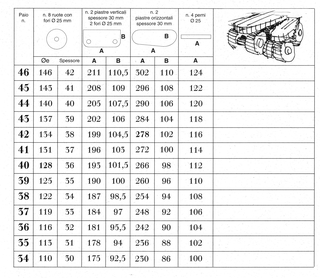
Correspondence table of the 13 specimens
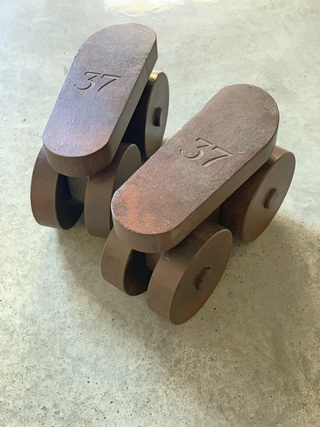
Nº37 Courtesy Lara e Rino Costra Arte Contemporanea
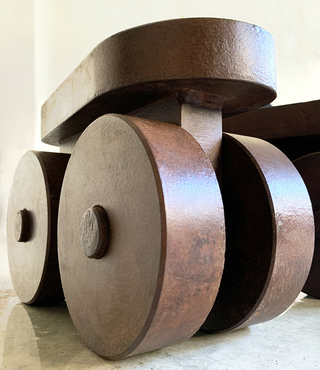
Detail of the right element of nº37
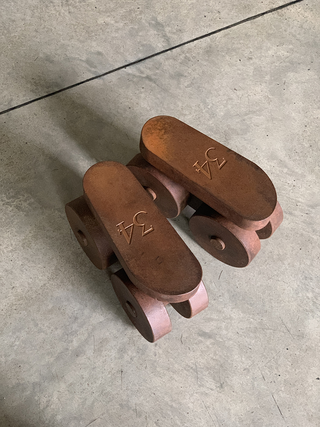
Nº34 Courtesy Lara e Rino Costra Arte Contemporanea

Nº35 Courtesy Lara e Rino Costra Arte Contemporanea
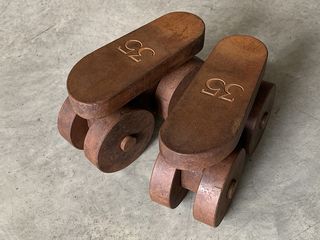
Nº35 Courtesy Lara e Rino Costra Arte Contemporanea
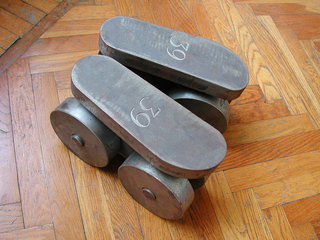
Nº39 Private collection, Milan
Social
Contatti
umberto@cavenago.info